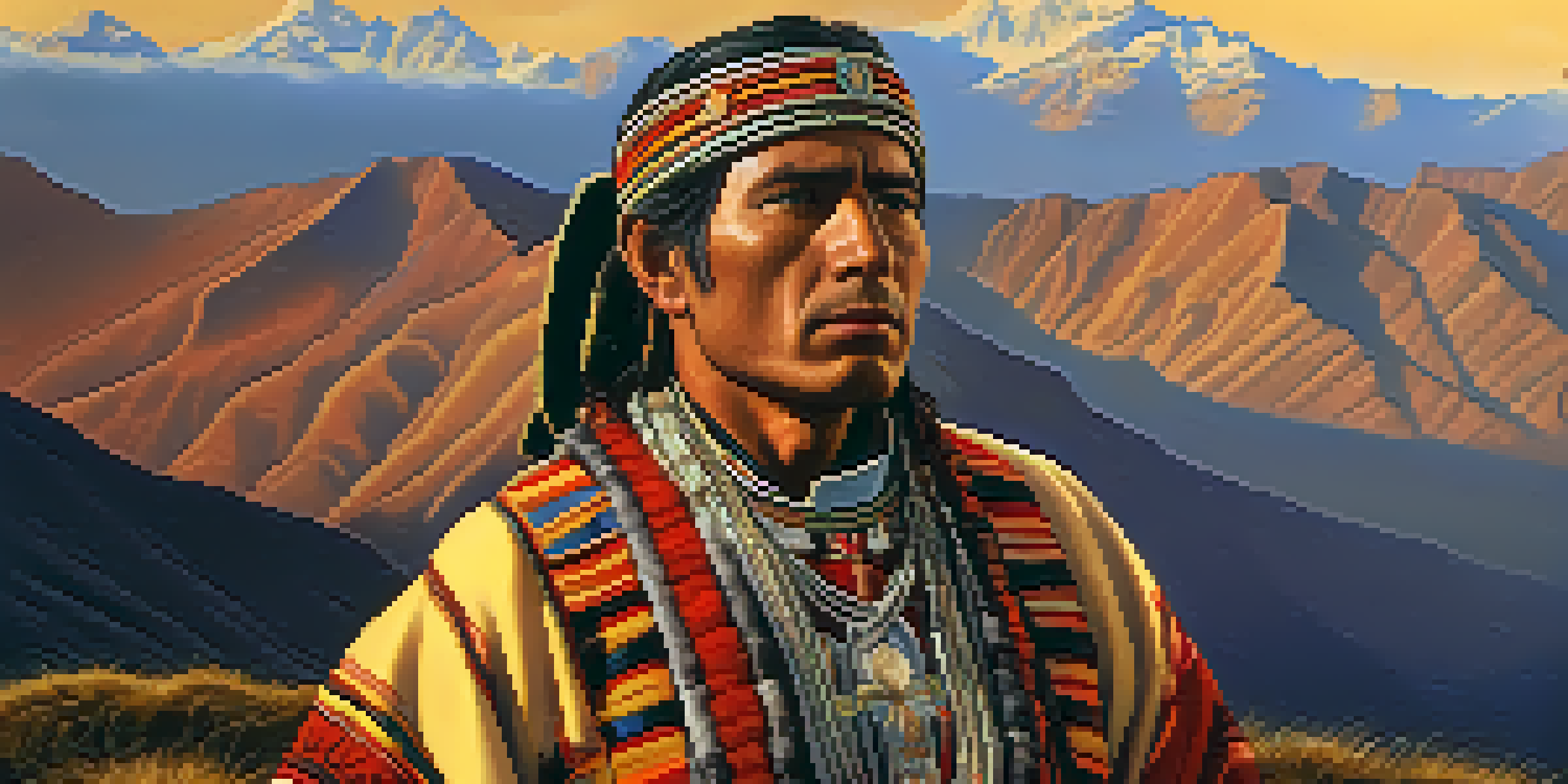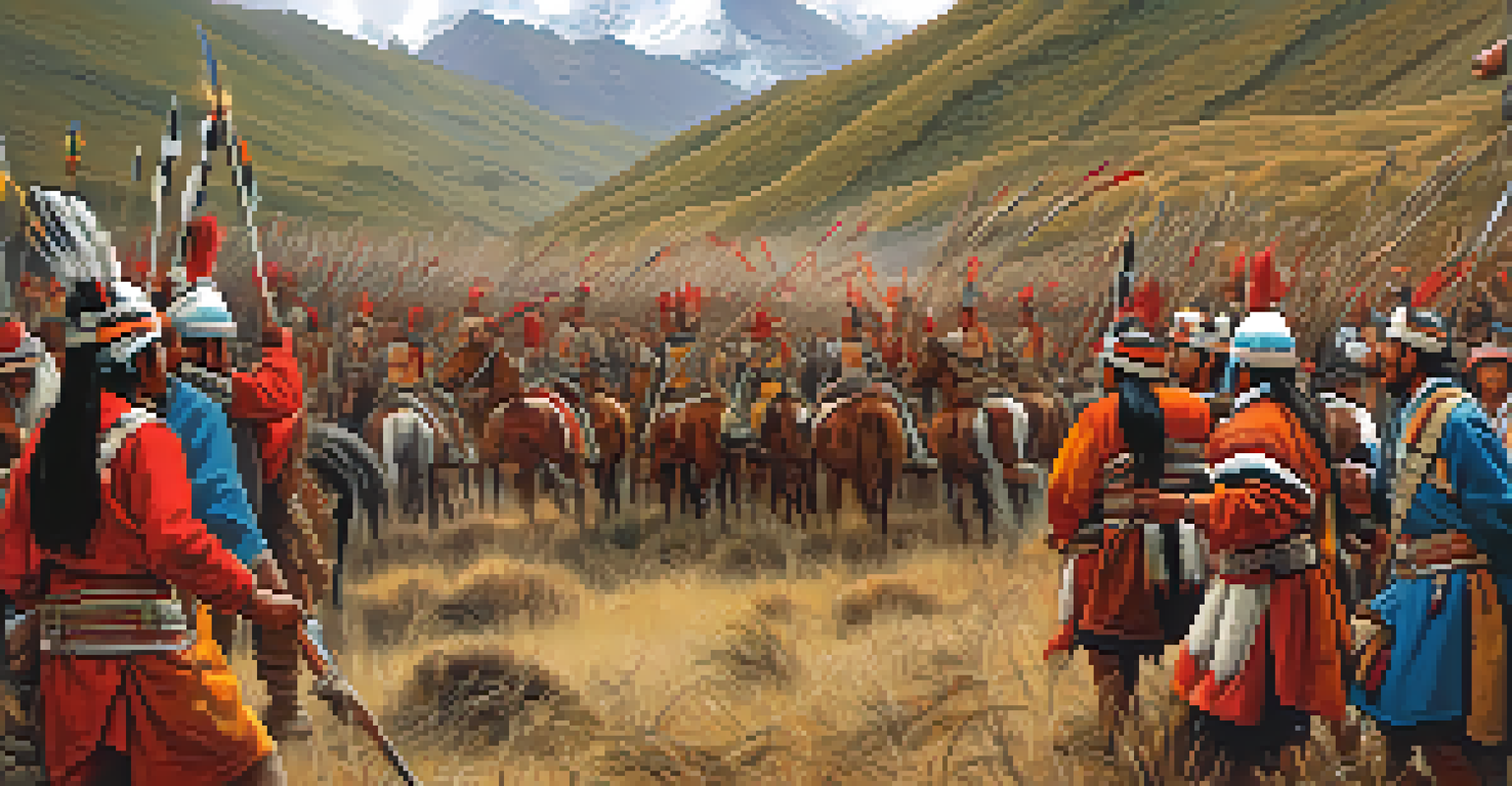Túpac Amaru II: The Indigenous Rebellion Leader

Introduction to Túpac Amaru II: A Revolutionary Figure
Túpac Amaru II, born José Gabriel Condorcanqui, emerged as a critical voice for the indigenous people of Peru in the late 18th century. His leadership during the indigenous rebellion against Spanish colonial rule marked a significant chapter in South American history. This rebellion was not just a fight for independence; it was a struggle for dignity and rights that resonated deeply with the oppressed.
The true measure of a man is what he would do if he knew he would never be caught.
Raised in the rural Andes, Túpac Amaru II was acutely aware of the injustices faced by his people under colonial rule. He was educated and held the title of 'curaca,' a local leader, which provided him with insights into both indigenous culture and colonial politics. This unique background enabled him to rally various indigenous groups to his cause, igniting a flame of resistance.
Ultimately, Túpac Amaru II's vision extended beyond mere rebellion; he dreamed of a society where indigenous people could reclaim their rights and governance. His story is a powerful reminder of the enduring spirit of resistance against oppression and the quest for social justice.
The Early Life of Túpac Amaru II: Background and Influences
Túpac Amaru II was born in 1740 in the town of Surimana, near Cusco, Peru. From a young age, he was influenced by the rich traditions of the Quechua people and their struggles against Spanish oppression. His upbringing instilled in him a deep sense of identity and responsibility towards his community.

His education at the colonial institution of the Jesuits exposed him to Enlightenment ideas, which emphasized freedom and equality. This exposure fueled his desire for reform and justice for his people, setting the stage for his later revolutionary activities. The contrast between his education and the harsh realities faced by indigenous people only strengthened his resolve.
Túpac Amaru II's Fight for Rights
He led a significant rebellion against Spanish colonial rule, advocating for the dignity and rights of indigenous people.
Additionally, witnessing the heavy taxation and forced labor imposed by the Spanish authorities propelled him to take action. His early life experiences shaped Túpac Amaru II into a leader who would not only fight for his rights but also inspire others to do the same.
The Catalyst: Events Leading to the Rebellion
The rebellion led by Túpac Amaru II was not an impulsive decision; it was catalyzed by a series of oppressive policies imposed by the Spanish crown. Increasing taxes, forced labor, and the loss of traditional lands created a perfect storm of resentment among the indigenous population. Túpac Amaru II saw the suffering of his people and decided it was time to take a stand.
Injustice anywhere is a threat to justice everywhere.
In 1780, the execution of a local indigenous leader for resisting tax collection ignited Túpac Amaru's anger and served as a rallying cry. He took decisive action by capturing the Spanish governor, Antonio Arriaga, which marked the beginning of a widespread revolt. This bold move not only showcased his leadership but also galvanized support from other indigenous groups across the region.
The rebellion quickly gained momentum, attracting thousands of followers who were inspired by Túpac Amaru II's vision of independence and justice. His ability to unite various indigenous groups under a common cause was a testament to his charisma and commitment to their shared struggle.
Key Events of the Rebellion: Strategies and Battles
The rebellion led by Túpac Amaru II unfolded over several intense months, marked by strategic battles and significant victories against the Spanish forces. His forces initially captured several towns, showcasing their determination and ability to challenge colonial authority. These early successes emboldened more indigenous people to join the fight.
Túpac Amaru II employed guerrilla warfare tactics, utilizing the rugged Andean terrain to his advantage. This strategy not only surprised the well-trained Spanish troops but also allowed the rebels to engage in hit-and-run attacks, disrupting supply lines and communications. The rebellion became a symbol of hope for many oppressed communities across Peru.
Legacy of Resistance and Hope
His execution turned him into a martyr, inspiring future generations to continue the struggle for indigenous rights.
Despite initial successes, the rebellion faced challenges as Spanish reinforcements arrived. Over time, the tide turned against Túpac Amaru II, leading to significant losses and eventual setbacks that tested the resolve of his followers. Nevertheless, the bravery displayed during these battles left an indelible mark on the history of indigenous resistance.
The Downfall: Betrayal and Capture
As the rebellion progressed, Túpac Amaru II faced increasing challenges from both external forces and internal dissent. The initial unity among indigenous groups began to fray as differing priorities and strategies emerged. This fragmentation weakened the overall effectiveness of the rebellion and made it vulnerable to Spanish reprisals.
In 1781, Túpac Amaru II was ultimately betrayed by a trusted ally, leading to his capture. The Spanish authorities, eager to quash the rebellion, put him on trial and tortured him to extract information about the remaining rebel leaders. His capture marked a turning point in the rebellion, bringing an end to the organized resistance he had led.
Despite his capture, Túpac Amaru II remained defiant, refusing to renounce his cause even in the face of death. His bravery and unwavering commitment to justice resonated with his followers, solidifying his legacy as a martyr for indigenous rights.
The Execution of Túpac Amaru II: A Martyr's Legacy
On May 18, 1781, Túpac Amaru II was executed in a brutal display of colonial power. The manner of his execution was intended to serve as a warning to others who might consider rebellion against the Spanish crown. Despite this horrific end, his death became a rallying point for future generations of indigenous leaders.
The legacy of Túpac Amaru II transcended his lifetime; he became an enduring symbol of resistance against oppression. His story inspired countless movements across Latin America, where indigenous people continue to fight for their rights and cultural identity. Over the years, monuments and memorials have been erected in his honor, celebrating his struggle.
Influence on Modern Indigenous Movements
Túpac Amaru II's story continues to resonate with contemporary activists fighting for land rights and cultural preservation.
Today, Túpac Amaru II is remembered not just as a revolutionary leader, but as a symbol of hope for marginalized communities. His commitment to justice and dignity continues to inspire activists and movements advocating for indigenous rights around the world.
The Influence of Túpac Amaru II on Modern Indigenous Movements
The impact of Túpac Amaru II's rebellion extends far beyond the 18th century, influencing modern indigenous movements across Latin America. His fight for rights and dignity resonates with contemporary struggles faced by indigenous people today, including land rights and cultural preservation. Activists often invoke his name as a source of inspiration and strength.
In Peru, various organizations and communities continue to honor his legacy through cultural events, educational programs, and political advocacy. Túpac Amaru II’s story serves as a reminder of the ongoing fight against systemic injustices and the importance of indigenous voices in shaping their futures. His spirit is alive in the hearts of those who seek liberation from oppression.

The legacy of Túpac Amaru II also encourages a broader conversation about identity, heritage, and the recognition of indigenous rights on a global scale. As societies evolve, his story remains a powerful testament to the resilience of those who dare to dream of a more equitable world.